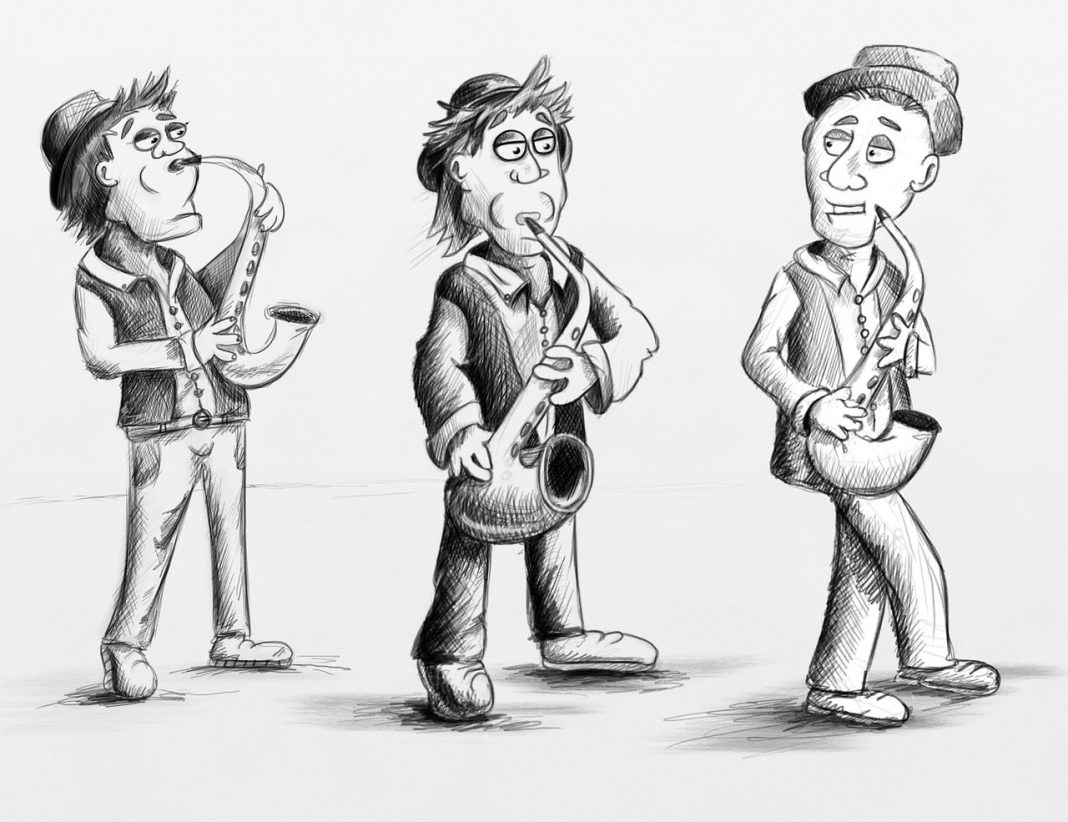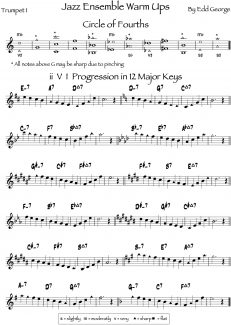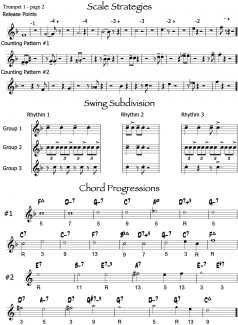Director’s Notes
Here is a description of the exercises in the order that they appear in the warm-ups, along with suggestions for implementation.
Download a full score
Download a complete set of parts
Circle of Fourths
It is important for students to learn the Circle of Fourths because in many chord progressions the roots follow the same sequence. (It is also the order of the flats.)
- For consistency, it is best to always end on the same note you start on. (For example, start on concert C, play all 12 tones, then end on concert C.)
- You can start on any note and then repeat back to the beginning of the line to complete the circle of fourths.
- The parts have been written with multiple octaves. You should vary instructions to the students by having them play the most comfortable octave, then another day play the lowest octave possible, then the highest octave possible, etc.
- Use different rhythms for variety and ensemble tightness.
- You can use the Circle of Fourths along with descending chromatic scales to play dominant 7 chords:
Group 1 plays a descending chromatic scale starting on concert Bb
Group 2 plays a descending chromatic scale starting on concert E
Group 3 plays around the Circle of Fourths starting on concert C
- Have different sections of the band start on different notes to build other chords: For example, to get the band to play half diminished chords in all keys:
Group 1 starts on concert Bb and plays around the Circle of Fourths
Group 2 starts on concert Db and plays around the Circle of Fourths
Group 3 starts on concert E and plays around the Circle of Fourths
Group 4 starts on concert Ab and plays around the Circle of Fourths
- In following the American Band College standard pitch tendency notation, triangle-shaped note heads indicate notes that have a sharp tendency, square-shaped note heads (with flat sides) indicate notes that have a flat tendency. The severity of the pitch tendency is notated with S for Slightly, M for Moderately and V for Very. The note heads are consistently marked throughout the warm-ups but the distinction of S, M, V are only shown in the circle of fourths. Students should memorize the tendencies for their instrument.
- Students should be instructed on how to correct flat or sharp notes. o Flat Notes on Brass Instruments can be corrected by raising the tongue (more of an “eee” shape), and by using faster air. o Sharp Notes on Brass Instruments can be corrected by lowering the tongue, lowering the jaw and by lowering the corners of the embouchure.
- Trombone players must adjust their slide position as well as adjust with their embouchure and air.
- Trumpet players should use their 3rd valve slide on the notes D and C# at the bottom of the staff.
- Flat Notes on Reed Instruments can be corrected by firming up the embouchure, raising the jaw and by using faster air.
- Sharp Notes on Reed Instruments can be corrected by bringing the corners of the mouth down and flattening the chin.
- Sharp Notes on Flute can be corrected by tilting the head down slightly or rolling the head joint in.
- Flat Notes on Flute can be corrected by tilting the head down slightly or rolling the head joint out.
ii V I progressions in 12 Major Keys
This exercise takes the students through 12 major scales in descending quarter notes while the rhythm sections plays ii V I chord progression.
- This can be played along with Aebersold Volume 3, Track 2.
- Have the band repeat each key twice (4 measures), brass playing once then woodwinds playing once. Students can finger and sing when they are not playing. The rhythm section should play the entire time. Challenge the advanced students to just look at the chord symbols and play the scale without having to read each note.
- For theory practice have students identify the chord tones for each chord. (The 3rds and 7ths are most important.) Have the brass players pick chord tones to play softly as whole notes while woodwinds play the scales and then switch.
- Allow students to improvise rhythms while playing the scale. Restricting the students to the 4 notes written in each measure will help them change chords at the right time and give them practice at hearing the resolution of the 3rds and 7ths.
- Allow students to improvise over the chord progression as sections or small groups, then as individuals as they feel more comfortable. Remind them to stay within the major key.
- Most students feel more comfortable playing ascending major scales, and this exercise forces them to practice them descending.
Scale Strategies
These are 3 exercises that you can use while playing scales to work on rhythmic accuracy and unity of ensemble articulation. Once the students are comfortable with the different exercises, it is beneficial to play scales in different keys and different types of scales (major, dorian, mixolydian and aeolian being the most important.)
Release Points
- This can be played with straight eighth notes or swing eighth notes at a variety of tempos.
- The goal is to release the notes at the same time. (breathe in on the release) The drummer should work on setting up the band on beat 1 of every other measure.
- The scale used in this exercise is Eb Major, which corresponds to major seventh chords.
Counting Pattern #1
- Work on articulation always being long-short (du-dot or du-dit.)
- The drummer should work on playing those hits with the band. o To play with the band, the ride cymbal and high hat play a standard swing rhythm. The rhythm the band is playing is written above the staff and the drummer should play those rhythms on one of the drums.
- Have the drummer play while the band (and rest of the rhythm section) sings the exercise.
- It is helpful to do this exercise with a metronome amplified so the band can hear it.
- The scale used in this exercise is Eb Mixolydian, which corresponds to dominant seventh chords.
Counting Pattern #2
- This helps work on counting through the measure. The students should subdivide through the exercise, and work on not rushing.
- The drummer should work on setting up the band for these different entrances. o To set up the band, they should work on leading up to the downbeat before the bands’ note.
- It is helpful to do this exercise with a metronome amplified so the band can hear it.
- The scale used in this exercise is Eb Dorian, which corresponds to minor seventh chords.
Swing Subdivision
These are 4 count rhythmic figures that can be used when playing unison pitches, scales or the Circle of Fourths. These are common swing rhythms, and are designed to give student practice in feeling swing subdivision. It is important that the students make these rhythms “line up” and articulate together. Each of the rhythms is divided into 3 groups that should be played concurrently.
- Pick one of the Rhythms and assign everyone to Group 1. Once the ensemble plays that rhythm accurately, assign half the band to be Group 2, while the rest of the ensemble continues to be Group 1. When those 2 rhythms accurately fit together, then assign part of the ensemble to the Group 3 rhythm, and have all 3 Groups playing together.
- Rotate the assignment of trombones, trumpets, woodwinds and rhythm section to each of the 3 groups.
- Have the band play a scale (major, minor, mixolydian) or the Circle of Fourths, 1 pitch per measure.
- It is helpful to do this exercise with a metronome
Chord Progressions
The scores for the two passages are included on the following page. These are jazz chorales that are designed to be used for balance and tuning. Each part has the chord symbols, as well as an indication of the notes’ place in the chord. For example a “3” below a note means that student is playing the 3rd of the chord, (“R” = Root). Many of the chords are written as seventh chords (F7) actually include the 9th, 13th or 11th. It is common for these notes to be added by jazz musicians to enhance the chord.
Chord Progression #1 is based on the jazz standard “The Way You Look Tonight,” Progression #2 is based on the bridge to Rhythm Changes in Bb. (with some substitutions)
- When tuning a chord, have students join in the following order: R, 5, 3, 7, 9, 13, 11
- Teach theory by asking “Is that a minor 3rd or major 3rd?” “How can you tell?”
- Take a chord and transpose it to a different key. (If the chord is a C minor 7, have the band play a D minor 7)
- Instruct the students to listen for moving parts in the inner voices
- The drummer can play time or work on cymbal textures as in a ballad
- Conduct dynamics, and don’t always do it the same way
- Have each horn section play with the rhythm section while the other horn sections listen for the measures of best and worst intonation.
- Get the students to listen for how different notes sound in a chord, so they can recognize when they are playing a 3rd or a root in their jazz band music
- In the conductor score the chords are printed in the Alto, Trumpet and Bass part, so you can easily see them in each of the common transpositions
- Have students improvise over the changes as sections or individually
- Advanced students could write melodies to the progressions.








